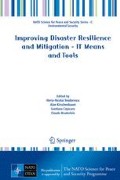Abstract
The methodology for foresight and forecasting of social, technological and environmental disasters for prevention, mitigation and recovering after disaster situations is considered. The proposed approaches can be effectively applied both for a preliminary forecast of possible disasters and for modelling, preparation and evaluation of measures to prevent and control potential disasters. Methods also allow obtaining and improving of the control and managing in disasters, and provide decision-making support for disaster situations. Developed approaches are very flexible to use in systems of various nature, such as technical, environmental, social, human, economic and others. Developed tools allow reducing the time, financial and human resources for recovering from the effects of disasters in conditions under inaccuracy, incompleteness, fuzziness, untimeliness, noncredibility, and contradictoriness of information.
Access this chapter
Tax calculation will be finalised at checkout
Purchases are for personal use only
References
Balakrishnan AV (1984) Kalman filtering theory. Optimization Software, Inc., New York, 222 p
Korbicz J, Bidyuk PI (1993) State and parameter estimation. Technical University of Zielona Gora, Zielona Gora, 303 p
Zgurovsky MZ, Podladchikov VM (1995) Analytic methods of Kalman filtering. Naukova Dumka, Kyiv, 285 p
Cowell RG, Dawid AP, Lauritzen SL, Spiegelhalter DJ (1999) Probabilistic networks and expert systems. Springer, New York, 321 p
Baum LE, Petrie T (1966) Statistical inference for probabilistic functions of finite state Markov chains. Ann Math Stat 37(6):1554–1563
Ivakhnenko AG (1982) An inductive self-organization method for complex systems models. Naukova Dumka, Kyiv, 296 p
Dobson A (2002) An introduction to generalized linear models. CRC Press Company, New York, 221 p
Bidyuk PI, Romanenko VD, Timoshchuk OL (2013) Time series analysis. Polytechnika, NTUU “KPI”, Kyiv, 607 p
Zgurovsky MZ, Pankratova ND (2007) System analysis: theory and applications. Springer, Berlin/London, 475 p
Saaty TL (2008) Decision making with the analytic hierarchy process. Int J Serv Sci 1(1):83–98
Pankratova N, Nedashkovskaya N (2013) Estimation of sensitivity of the DS. AHP method while solving foresight problems with incomplete data. Intell Control Autom 4(1):80–86. doi:10.4236/ica.2013.41011
Pankratova N, Khokhlova L (2012) Integrated tools for restoration of oil polluted soils and water bodies. Int J Inf Theories Appl ITHEA SOFIA 12(1):39–49
Pankratova ND, Savastiyanov VV (2009) Modeling of alternatives in the technology foresight scenarios. Syst Res Inf Technol 1:22–35
Khohlova L, Shvets D, Khohlov A (2004) Patent of Ukraine № 43974. СО2F3/34, ВО1J20/20. A sorption bio-destructive material for cleaning up the soil and water subsurface from oil and petroleum products. Published on 15.03.2004, Bulletin №3
The application of bioactive sorbent in oil spill in the fields of OGDP Barsukovneft (Rosneft) (2001–2003) Russia № 00–2 ПН-01, Joint research project UKRAINE-Russia, Аrea of investigation: ecology
Pankratova ND, Zavodnik VV (2004) System analysis and evaluation of dynamics for ecological processes. Syst Anal Inf Technol 2:70–86
Buneman P (1997) Semistructured data. In: Proceedings of the ACM symposium on principles of database systems. Abstract of invited tutorial, Tucson, pp 117–121
Hu M, Liu B (2004) Mining opinion features in customer reviews. In: Proceedings of nineteenth national conference on artificial intelligence (AAAI-2004), San Jose, July 2004
Reckman H, Baird C, Crawford J, Crowell R, Micciulla L, Sethi S, Veress F (2013) Rule-based detection of sentiment phrases using SAS Sentiment Analysis. http://www.cs.york.ac.uk/semeval-2013/accepted/79_Paper.pdf
Author information
Authors and Affiliations
Corresponding author
Editor information
Editors and Affiliations
Rights and permissions
Copyright information
© 2014 Springer Science+Business Media Dordrecht
About this paper
Cite this paper
Pankratova, N.D. et al. (2014). Foresight and Forecast for Prevention, Mitigation and Recovering after Social, Technical and Environmental Disasters. In: Teodorescu, HN., Kirschenbaum, A., Cojocaru, S., Bruderlein, C. (eds) Improving Disaster Resilience and Mitigation - IT Means and Tools. NATO Science for Peace and Security Series C: Environmental Security. Springer, Dordrecht. https://doi.org/10.1007/978-94-017-9136-6_8
Download citation
DOI: https://doi.org/10.1007/978-94-017-9136-6_8
Published:
Publisher Name: Springer, Dordrecht
Print ISBN: 978-94-017-9135-9
Online ISBN: 978-94-017-9136-6
eBook Packages: Computer ScienceComputer Science (R0)

